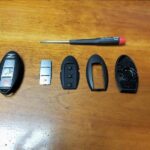The key fob, a staple in modern car ownership, is more than just a convenient gadget. It’s your gateway to effortless vehicle access and security, allowing you to lock, unlock, and even start your car with a simple press of a button. But have you ever paused to consider the name itself? What exactly does “fob” mean in “key fob”? Let’s delve into the intriguing origin of this term and explore the evolution of the device we rely on daily.
The ‘Fob’ in Key Fob: A Historical Journey
To understand “fob” in the context of car keys, we need to take a trip back in time. The word “fob” has a fascinating history, evolving through different meanings over centuries. Originally, dating back centuries, a fob referred to a small pocket sewn into clothing, designed for carrying valuables like watches or money. Think of it as a secure, discreet pouch.
By the turn of the 20th century, the meaning of “fob” shifted slightly. It began to describe the ornamental attachment dangling from a pocket watch chain. These fobs were often decorative and could signify status or personal style. Imagine a distinguished gentleman with a pocket watch, a chain elegantly looped to a fob – that’s the image we’re painting.
Moving into the mid-1900s, “fob” broadened its definition again, becoming a general term for any decorative ornament hanging from a keychain. This is closer to our modern understanding, where keychains can feature various charms and trinkets – fobs in this sense.
So, how does this history connect to our car key fobs? When remote keyless entry systems emerged and gained popularity in the 1980s, the automotive world needed a term for these new remote transmitters. Drawing on the existing association of “fob” with small, handheld attachments, car dealers and mechanics naturally started using “fob” to describe the remote transmitter that controlled car locks. The term “key fob” simply combined the familiar “key” with this newly adopted “fob,” creating a descriptive name for the key-like remote.
How Key Fobs Work: Modern Convenience
Beyond the name’s origin, understanding how key fobs function highlights their technological evolution. At their core, key fobs are essentially radio transmitters. When you press a button, the fob sends a unique radio signal to your car’s onboard computer. This computer recognizes the signal and triggers the corresponding action – unlocking doors, locking the vehicle, opening the trunk, or even starting the engine in some models.
Modern key fobs often utilize rolling code technology. This sophisticated security measure ensures that each time you use your fob, it transmits a different code. This prevents thieves from intercepting and reusing codes to gain unauthorized access to your vehicle, adding a layer of crucial security.
Security and the Modern Key Fob
While incredibly convenient, key fobs also present certain security considerations. One potential vulnerability is a “relay attack,” where thieves can use electronic devices to amplify and relay the signal from your key fob to your car, even from a distance. This can trick your car into thinking the fob is nearby, allowing unauthorized entry and even ignition.
To combat these risks, car manufacturers are constantly implementing enhanced security measures. These include motion sensors within fobs that deactivate them when not in motion and biometric authentication in some high-end models, adding layers of protection against sophisticated theft techniques. For added peace of mind, you can also use a Faraday Key Fob Pouch, which blocks electromagnetic signals, preventing relay attacks by isolating your fob’s signal.
Key Fob Practicalities: Batteries and Replacements
Like any electronic device, key fobs rely on batteries to function. These batteries need periodic replacement, and the type of battery can vary depending on your car model. Some fobs are designed with easily accessible battery compartments, while others might require a bit more effort or even professional assistance for battery replacement.
Losing or damaging a key fob can be a frustrating and potentially expensive experience. Key fob replacements from dealerships can be costly. However, specialized services like Remotes and Keys offer more affordable alternatives for replacing and reprogramming key fobs, ensuring you can get back on the road without breaking the bank. When seeking a replacement, it’s crucial to ensure compatibility with your car’s specific make and model to guarantee seamless functionality.
In conclusion, the term “fob” in “key fob” carries a rich history, originating from a word signifying a small pocket for valuables and evolving to describe ornamental attachments. Today, it aptly names the small, handheld remote transmitters that grant us keyless access to our vehicles. Understanding the etymology of “fob” adds an interesting layer to our appreciation of this ubiquitous device that blends convenience and security in modern automotive technology.
